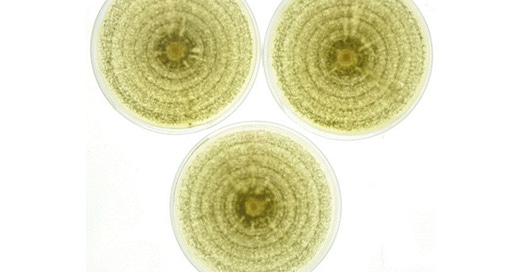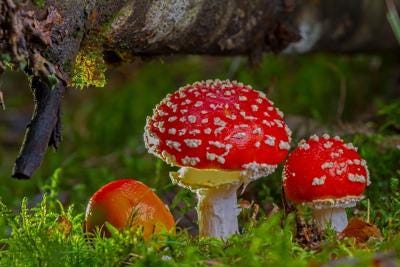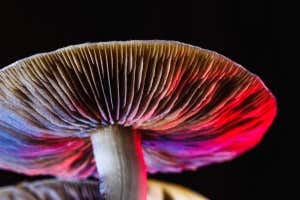Hello Fungi Friday fam,
Welcome back for yet another edition of your favorite fungi publication on the web. Hope everyone had a wonderful Thanksgiving (for all whom celebrate here in the states) and everyone else is ready for another weekend! Currently i’m just getting going on my yearly Polish tradition of preparing the family’s yearly supply of pierogi, stuffed with everything from sauerkraut, bakers cheese, and my personal favorite spinach and MUSHROOMS!
As far as the mushroom operation goes, all we can really do at this point is plan for next season. Fields are just about harvested, so once that wraps up, we’ll finally get our trailer moved and it’ll be a waiting game until April. Big plans for next year, just you wait and see!
But let’s get on to our stories…
A fungus growing naturally on roots is found to detoxify mercury in soil and water
This first story is pretty wild, and that’s coming from me… the guy who writes about all of the cool stuff that fungi do each week. As many people would agree, our environment is of the utmost importance. It’s our home and we must take care of it. Therefore, it makes sense why so many are rightly concerned about greenhouse gases. Another facet of the warming of the planet that many don’t seem to know about though is the often overlooked increasing accumulation of acutely toxic forms of mercury in our environment and in the food chain.
Mercury occurs naturally in the Earth’s crust, where it is safely sequestered away and doesn’t bother anyone. While it can be released into the air by volcanic activity, that hasn’t been much of a problem for life on Earth. But burning fossil fuels — especially coal — has increased the rate of mercury emissions into the air quite significantly, and this continues to be problem.
That’s where the fungi come in… A fungus called Metarhizium robertsii that has a symbiotic relationship with many crops not only can increase their yields and protect them from insect invasions, but it can also absorb and detoxify methylmercury, allowing the plants to grow with minimal mercury accumulation even in polluted soils. The fungus can even remove methylmercury from freshwater and saltwater.
The article goes into great details on how this fungus operates, but the TL/DR ultimately shows that these fungi could actually protect plants from mercury naturally, giving us a way to remediate an agricultural site even as we still grow plants on it, and also gave us a benign and low-cost way to get methylmercury out of bodies of water! All by observing nature and being smart enough to learn from it.
Fungi are fundamental: Scientists say spore producers can mitigate climate change
Keeping on the environmental front, article number two today breaks down all the different ways that fungi play a positive effect on our environment. Fungi are seen by many researchers as the threads that help stitch ecosystems together. They attach themselves to plant roots and diverge in all directions, indirectly connecting the most majestic trees with the tiniest sources of nitrogen and other elements needed to maintain life. Mycelia, the root-like structures of fungi, are the vessels through which this connection happens.
“Almost everyone knows about the computer internet. The mycelium shares the same network design,” mycologist Paul Stamets says in “Fantastic Fungi.”
Fungi are also able to help trees, plants and other vegetation recover from catastrophic weather events. Although research on this topic has been sparse, a general principle holds that recovery happens more quickly in forested areas due to higher volumes of organic matter in the soil there. The more organic matter present, the more fungi can help nature heal itself.
“Generally speaking, because that forested ecosystem with the high amount of leaf litter and organic matter that settles in that situation, we should expect to see fungi be a very large part of the recovery of that system due to the high initial populations,” he said.
Whether it be cleaning up pollution, as in article one, or aiding trees, plants and roots in healthy growth, fungi are always there, helping keep our environment strong and healthy for us humans, and for that we should be thankful!
Psychedelic drugs may reopen critical learning periods in the brain
Our final article this week is short and sweet (darn paywall). Ultimately it shows that in a new adult mice study, psychedelic drugs including LSD, ketamine and psilocybin have been shown to reopen the brain to a critical window for social learning usually only seen in adolescents.
This re-opening stimulates critical windows of brain development and learning in adult mice, that are typical only during the adolescent phase.
During these “critical periods”, the brain is highly plastic and capable of learning specific skills such as language. Once this window closes, it is nearly impossible to acquire certain abilities. For instance, children who aren’t exposed to language in their first year of life may never fully grasp sentence structure.
You’re probably familiar with the phrase, “can’t teach an old dog new tricks”… and there is certainly some science to that. It’s more difficult to learn new skills as we age, but through the use of psychedelic mushrooms, that may not always be the case!
Want even more? Here are some other interesting, mushroom focused reads of the week:
Mystery parasites on zombie ant fungus identified by scientists
Mushroom Skin Could Be the Secret to Reducing Electronic Waste
As always, thank you for reading this weeks edition of Fungi Friday’s! We are especially thankful for all of you who spend your Friday lunch with us, learning about all things Fungi. If you enjoyed what you found, please feel free to forward to friends also interested in the Fungi Community!
And if you were forwarded this post and enjoyed what you found, please subscribe below:




